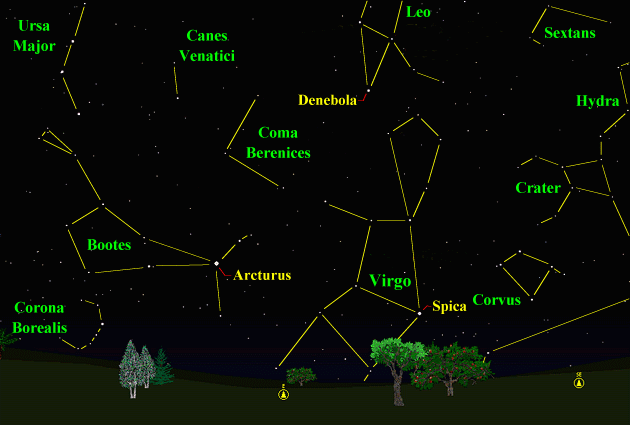The purpose of this feature is to give scout leaders, educators and naturalists an idea of some of the natural events coming up each month. We will try to cover a variety of natural events ranging from sky events to calling periods of amphibians, bird and mammal watching tips, prominent wildflowers and anything else that comes to mind. We will also note prominent constellations appearing over the eastern horizon at mid-evening each month for our area for those who would like to learn the constellations. If you have suggestions for other types of natural information you would like to see added to this calendar, let us know!. Note: You can click on the hyperlinks to learn more about some of the featured items. To return to the Calendar, hit the "back" button on your browser, NOT the "back" button on the web page. All charts are available in a "printer friendly" mode, with black stars on a white background. Left clicking on each chart will take you to a printable black and white image.
Notes and Images From February 2007
We had cold weather for our February wildlife surveys at the Pelham Range in Anniston, Alabama. Much of the wetland shown above was frost-covered and a layer of ice was present on the open water. Winter birds abounded though, and we saw Song, Swamp, White-throated, White-crowned, Chipping, Savannah and Fox Sparrows. I heard several "chack" notes coming from the grassy edge, and a female Common Yellowthroat hopped into view. At the northern limit of its winter range, it seemed a little out of place on this cold morning. Sky Events for March 2007: Spring officially begins on March 20th at 7:07pm CDT. Evening Sky: Be sure and catch the total lunar eclipse on March 3rd. This may be photo opportunity, so if you have a camera, be ready. The moon rises fully eclipsed around 5:35pm CST. Since the moon's brightness varies greatly during total eclipses, the moon may or may not be visible to the naked eye as it rises. If it is a bright eclipse, you may get a pretty shot of it against the horizon. If you want to set up a shot in advance, the azimuth of the rising moon will be about 82 degrees, a little north of due east. The total phase of the eclipse ends at 5:58pm CST. Venus continues to climb higher in the evening twilight this month. It appears before any star or planet. This month is a good chance to see Saturn. The ringed planet is well place for viewing all month long. Look for it near the "sickle" of the constellation Leo about 45 degrees above the eastern horizon at dusk at mid-month. Morning Sky: Jupiter rises about 12:30am at midmonth. Mars is still in the morning twilight, rising a little after 4:00am. Mercury reaches greatest western elongation on March 22nd, but this is a poor apparition and it may not be visible to the naked eye. All times noted in the Sky Events are for Franklin, Tennessee and are Central Standard Time. These times should be pretty close anywhere in the mid-state area.
Constellations: The views below show the sky looking east at 9:30pm CST on March 8th. The first view shows the sky with the constellation outlines and names depicted. Star and planet names are in yellow. Constellation names are in green. The second view shows the same scene without labels. The bright star Arcturus, in Bootes, the Herdsman, makes its appearance this month in the early evening sky, a sure sign that Spring is here. Below Bootes is Corona Borealis, the Northern Crown. In the southeast, Virgo clears the horizon this month along with Corvus, the Crow. To download each chart in a format that will not drain your printer of black ink, simply click on each chart.
On Learning the Constellations: We advise learning a few constellations each month, and then following them through the seasons. Once you associate a particular constellation coming over the eastern horizon at a certain time of year, you may start thinking about it like an old friend, looking forward to its arrival each season. The stars in the evening scene above, for instance, will always be in the same place relative to the horizon at the same time and date each March. Of course, the planets do move slowly through the constellations, but with practice you will learn to identify them from their appearance. In particular, learn the brightest stars (Like Arcturus and Denebola in the above scene looking east), for they will guide you to the fainter stars. Once you can locate the more prominent constellations, you can "branch out" to other constellations around them. It may take you a little while to get a sense of scale, to translate what you see on the computer screen or what you see on the page of a book to what you see in the sky. Look for patterns, like the stars of the "Big Dipper." The earth's rotation causes the constellations to appear to move across the sky just as the sun and the moon appear to do. If you go outside earlier than the time shown on the charts, the constellations will be lower to the eastern horizon. If you observe later, they will have climbed higher. As each season progresses, the earth's motion around the sun causes the constellations to appear a little farther towards the west each night for any given time of night. If you want to see where the constellations in the above figures will be on April 8th at 9:30pm CST, you can stay up till 11:30pm CST on the March 8th and get a preview. The westward motion of the constellations is equivalent to two hours per month. A good book to learn the constellations is H. A. Rey's classic, The Stars, A New Way to See Them. Rey's depictions of the constellations and witty commentary are terrific. A good general reference book on astronomy is the Peterson Field Guide, A Field Guide to the Stars and Planets, by Pasachoff. The book retails for around $14.00. A good beginners software program for learning the night sky is the Starry Night Beginner program. Visit the Starry Night web site at www.starrynight.com The program retails for around $30.00 and contains a wealth of information.
Amphibians:
With the unusually warm temperatures this year, some species are calling earlier than we normally hear them. Southern Leopard Frogs were already calling and breeding in January. Southeastern Chorus Frogs and Spring Peepers also began calling in January. American Toads, if you have not heard them yet, should be calling soon. Look for their eggs, and for the egg masses of Wood Frogs, Spotted Salamanders and Tiger Salamanders. In West Tennessee, Northern Crawfish Frogs give their loud snoring calls in early March. At higher elevations, listen for Mountain Chorus Frogs. Towards the end of the month listen for Pickerel Frogs doing their "yeeooow" call. Remember that on mild nights you may find frogs and toads out foraging that you do not hear until later in the season, and the record-breaking temperatures we have been having may yield some very interesting early records. Listen for early treefrogs, like Cope's Gray Treefrog.
Birds:
This time of year is prime time to find owl nests. Since the leaves have not yet appeared on most trees, you can sometimes spot the old stick nests that the owls often use for nesting. Observe only at a distance and do not try to approach a nest, both for your own safety and to keep from flushing the owl off the eggs. The adult's absence, if it flushes, can allow the eggs to rapidly get too cold, and may doom the nest. Look and listen for the young Great Horned Owls. If you find a young owl on the ground, leave it there! Its parents will feed it on the ground. Well-meaning people sometimes take young owls they find on the ground to wildlife rehabilitation centers, thinking the young owls have been abandoned. This is not necessary, and it may prevent the owl from ever successfully living in the wild. Don't do it.
Recommended: Bird Finding in Tennessee, Michael Lee Bierly. A classic guide to finding birds in Tennessee. The Sibley Guide to Birds, David Allen Sibley The Sibley Guide to Birds of Eastern North America, David Allen Sibley An inexpensive guide for beginners is the Golden Guide for Birds.
Archives (Remember to use the back button on your browser, NOT the back button on the web page!) Natural Calendar February 2007 Natural Calendar December 2006 Natural Calendar November 2006 Natural Calendar September 2006 Natural Calendar February 2006
Natural Calendar
December 2005
Natural Calendar
November 2005
Natural Calendar
September 2005
Natural Calendar
February 2005
Natural Calendar
December 2004
Natural Calendar
November 2004
Natural Calendar
September 2004
Natural Calendar
February 2004
Natural Calendar
December 2003
Natural Calendar
November 2003
Natural Calendar
September 2003 Natural Calendar February 2003 Natural Calendar December 2002 Natural Calendar November 2002 Nature Notes Archives: Nature Notes was a page we published in 2001 and 2002 containing our observations about everything from the northern lights display of November 2001 to frog and salamander egg masses. Night scenes prepared with Starry Night Pro software All images and recordings © 2007 Leaps
|




